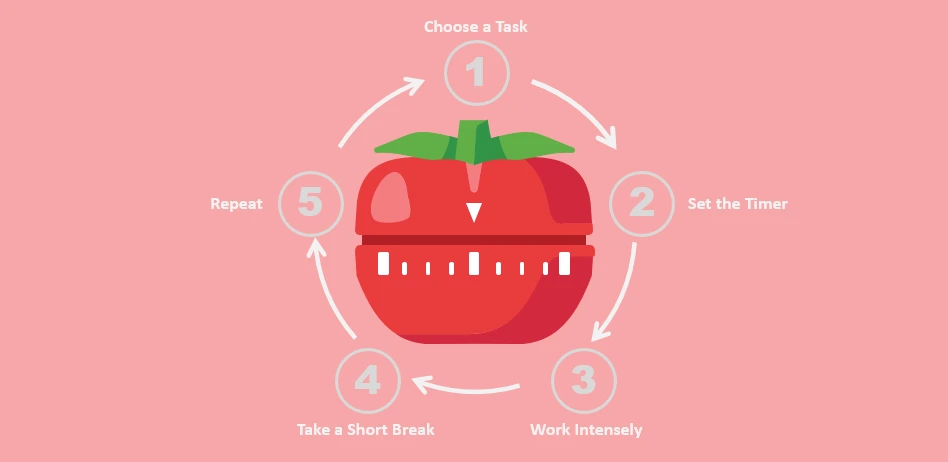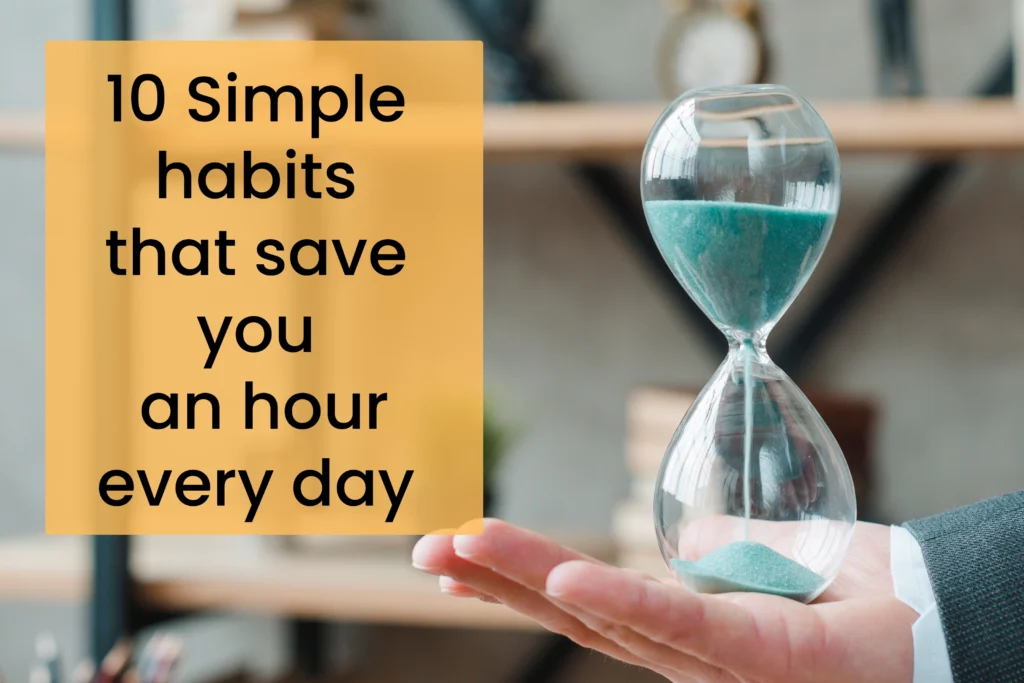In our fast-paced modern world, the quest for more time feels like an endless pursuit. We often dream of adding extra hours to the day, yet the secret to a more productive, fulfilling life isn’t about magical time travel. It’s about mastering the time we already have. The truth is, the most impactful changes don’t come from massive, life-altering decisions but from a series of small, consistent actions: simple habits.
These aren’t grand overhauls; they’re minor tweaks to your daily routine that, when added together, create a powerful ripple effect, ultimately saving you an entire hour, every single day. This article will delve into the profound power of these micro-habits, offering a practical, step-by-step guide to reclaiming 60 minutes of your life. By the time you finish, you’ll have the knowledge and tools to identify your personal time wasters and implement a powerful framework for lasting change.
The power of small changes: How tiny habits lead to massive time savings
Efficiency is not about doing more things faster. It’s about eliminating the need for speed by working smarter. Many people try to make drastic life changes all at once, only to fall back into old patterns. This happens because the brain resists major disruptions. Instead, focusing on simple habits that require minimal effort is a much more sustainable and effective approach. These tiny actions are easy to start and, over time, become so ingrained that they feel effortless, almost like second nature.
Understanding the compounding effect of efficiency
Think of your daily tasks as a financial investment. A small, consistent daily investment grows exponentially over time due to the power of compounding. Similarly, a 5-minute task completed efficiently every day saves you 25 minutes a week, over two hours a month, and a whopping 25 hours a year.
When you apply this principle to ten different simple habits, the time savings compound dramatically. Each small win builds upon the last, creating a cascade of efficiency that frees up valuable time for the things that truly matter to you, whether that’s a hobby, a side project, or simply relaxing.
Why Micro-Habits are more effective than drastic overhauls
Drastic overhauls often fail because they rely on motivation and willpower, two resources that are finite and easily depleted. Micro-habits, on the other hand, are so small and easy to perform that they bypass the need for intense motivation. They rely on the principle of “start small, scale fast.” By making the action ridiculously simple for instance, deciding to plan just one thing the night before you build a tiny victory. This small win releases a burst of dopamine, the brain’s “reward” chemical, which reinforces the behavior and makes you more likely to repeat it.
The neuroscience of habit formation and time management
Habit formation is a fascinating neurological process. The brain is hardwired to seek efficiency and conserve energy. When you repeat a behavior, the neural pathways associated with that action become stronger and more efficient. This is the neuroscientific basis for why simple habits become automatic. By intentionally repeating a productive action, you are literally rewiring your brain to be more efficient. This process, known as neuroplasticity, is a powerful tool for anyone looking to master their time.
The golden hour: Deconstructing Your day to find lost time
Before you can save an hour, you first need to understand where your time is going. Many people feel busy all day but can’t pinpoint what they’ve accomplished. This feeling is often a symptom of “time vampires”- small, seemingly insignificant activities that drain your time and energy without you even realizing it.
Auditing Your Time: A Step-by-Step Guide
Start by tracking your time for one week. Use a notebook, a spreadsheet, or a time-tracking app. Be brutally honest. Write down what you are doing in 15-minute increments. Include everything: checking social media, making coffee, and even staring into space. At the end of the week, analyze your data. You’ll likely be surprised by how much time is lost to unproductive activities.
Identifying Your personal time wasters (The “time vampires”)
Everyone has their own unique time vampires. For some, it’s the constant urge to check their email. For others, it’s getting lost in an endless scroll on social media. Common time vampires include:
- Excessive multitasking: Switching between tasks constantly, which studies show is less efficient than focusing on one thing at a time.
- Decision fatigue: Spending too much time deciding what to wear, what to eat, or what to work on first.
- Unscheduled interruptions: Getting sidetracked by co-workers, family members, or notifications.
- Disorganization: Searching for misplaced keys, documents, or tools.
Did you know? The average person checks their phone 85 times a day and spends a total of 5 hours a day on their mobile device. That’s a staggering amount of potential time to reclaim!
The principle of found time: Where to look for hidden opportunities
Once you identify your time vampires, you can start looking for “found time.” This is the time you didn’t know you had, often in the gaps between major tasks. For example, the time you spend waiting for a meeting to start, the minutes you have while coffee is brewing, or the short breaks you take throughout the day. These moments are perfect for applying simple habits that take two minutes or less.
Habit 1: The pre-mortem: Planning your day the night before

You wouldn’t start a road trip without a map, so why start your day without a plan? The single most effective habit for saving time is to spend 15 minutes the night before planning your next day. This simple ritual has a profound impact on your efficiency.
Why a 15-Minute Evening Routine is Your Morning’s Best Friend
When you wake up and have to decide what to do, you’re immediately activating your prefrontal cortex, the part of the brain responsible for decision-making. This leads to decision fatigue before your day even begins. By planning the night before, you wake up knowing exactly what you need to accomplish. This eliminates mental friction and allows you to start your day with purpose and clarity.
A Simple Checklist for Your Daily Plan
Your nightly plan doesn’t need to be complicated. A simple checklist can do the trick:
- Identify your top three priorities for the next day. These are the non-negotiable tasks that will move you closer to your goals.
- Review your calendar. Check for any meetings or appointments and make sure you’re prepared.
- Lay out your clothes. This is a minor task that saves you a few minutes but eliminates a morning decision.
- Tidy up your workspace. A clean desk in the morning helps you focus immediately.
Tools and Apps to Streamline Your Nightly Preparation
You don’t need fancy tools to start this simple habit. A pen and paper work perfectly. However, if you prefer digital, apps like Todoist, Trello, or even the Notes app on your phone can help you create and manage your daily plan. The key is to find a system that you’ll actually use.
Habit 2: The “two-minute rule”: batching quick tasks

Created by author David Allen, the “Two-Minute Rule” is a game-changer for anyone who feels overwhelmed by a long to-do list. The rule is simple: If a task takes less than two minutes to complete, do it immediately.
How to conquer procrastination with a simple mindset shift
Procrastination often stems from the overwhelming feeling of a large task list. The two-minute rule breaks this cycle by encouraging immediate action on small, manageable items. This builds momentum and gives you a series of quick wins. When you tackle these simple habits as they arise, they never pile up and become a source of stress.
Examples of tasks to apply the two-minute rule to
This rule can be applied to almost any area of your life. Examples include:
- Responding to a short email.
- Putting a dish in the dishwasher after you use it.
- Folding a piece of laundry.
- Sending a quick text message.
- Filing a document.
- Taking out the trash.
The psychology of ticking items off a to-do list
Each time you complete a task, no matter how small, your brain releases dopamine. This neurochemical makes you feel good and motivates you to keep going. By applying the two-minute rule, you’re essentially giving yourself a continuous stream of mini-rewards, which makes you feel more productive and energized throughout the day.
Habit 3: The digital detox: Taming notification chaos

Our digital devices are a primary source of distraction, constantly pulling our attention away from the task at hand. Notifications, in particular, are designed to interrupt your focus and are one of the biggest time wasters.
The real cost of constant distractions
Switching from one task to another, even for a moment, has a cognitive cost. It takes time for your brain to re-focus on the original task. According to a study from the University of California, Irvine, it takes an average of 23 minutes and 15 seconds to get back to the original task after a distraction. By silencing notifications, you protect your valuable focus and prevent this constant “context switching.”
A practical guide to optimizing your phone settings
Start by turning off all non-essential notifications. This includes social media apps, games, and news alerts. Only allow notifications for truly urgent communications from family or work. Use your phone’s “Do Not Disturb” mode during focused work periods. Also, consider turning your phone’s screen to grayscale. Studies have shown that a lack of color makes the phone less visually stimulating and less addictive.
Creating “focus blocks” to protect your productive time
Designate specific times in your day where you work without any digital interruptions. These “focus blocks” are periods where you put your phone away, close unnecessary tabs on your computer, and dive deep into a single task. This practice is a crucial simple habit for anyone who wants to reclaim their productivity.
Habit 4: The master of the inbox: Reaching “inbox zero”
Email can be a productivity black hole. If you don’t have a system for managing your inbox, it can become a source of constant stress and a major time suck. Reaching “inbox zero” – the state of having no unread emails – isn’t about perfection; it’s about having a clear, actionable system.

A proven system for processing email efficiently
Instead of constantly checking your email, designate 2-3 specific times during the day to process your inbox. When you do, follow this simple process for each email:
- Do it: If it takes less than two minutes, respond immediately and archive the email.
- Delegate it: If the email requires action from someone else, forward it and archive it.
- Defer it: If the email requires a longer response or action, add it to your to-do list and archive it.
Did you know? The first commercial email was sent in 1971. Today, over 306 billion emails are sent and received every day, making a system for managing them more important than ever.
The D-E-L-E-T-E Method for managing junk mail
Junk and promotional emails are a massive drain on your time. Apply this simple rule:
- Delete: If you know it’s junk, delete it immediately.
- Exchange: If it’s a promotional email from a company you don’t want to hear from, unsubscribe.
- Label: If it’s a recurring newsletter you want to read later, create a label or folder for it.
- Eliminate: If it’s from a person or company you’re no longer in contact with, block their email.
- Take action: Apply the “Do, Delegate, Defer” rule to the rest.
- Empty the folder: At the end of the session, empty your junk folder and feel the relief.
Setting boundaries: How to communicate your email response time
To truly master your inbox, you need to set clear expectations. Add a line to your email signature that states your typical response time, for example: “I check my email at 9 a.m. and 4 p.m. every day and will respond within 24 hours.” This helps manage others’ expectations and reduces the urge to constantly check your inbox for new messages.
Habit 5: The habit stacking technique: Layering for success
Habit stacking is a powerful strategy for building new simple habits by attaching them to existing ones. The idea is to piggyback a new habit onto a behavior you already perform automatically. This method uses existing neural pathways to make new habits stick.

What is habit stacking and how does it work?
The formula for habit stacking is simple: “After I [CURRENT HABIT], I will [NEW HABIT].” For example, you might already brush your teeth every morning. That’s your current habit. A new habit might be to meditate for two minutes. Your new habit stack would be: “After I brush my teeth, I will meditate for two minutes.” This technique bypasses the need for willpower because the trigger is already a part of your daily routine.
Examples of combining habits for maximum efficiency
- After I pour my morning coffee, I will write down my top three priorities for the day.
- After I eat lunch, I will go for a 5-minute walk.
- After I turn off my TV for the night, I will lay out my clothes for tomorrow.
Creating your own habit stack recipe
Look at your daily routine. What are the things you do without thinking? This could be drinking your first glass of water in the morning, putting on your shoes, or getting into your car. Now, think of a simple habit you want to start. Pair them up using the formula. Start with one and, as it becomes a part of your routine, add another.
Habit 6: The “one-touch” method: Handling physical clutter
Clutter isn’t just an aesthetic problem; it’s a time and energy vampire. Searching for things you need and living in a disorganized space drains your mental energy and wastes precious time. The “One-Touch” method is a simple but powerful solution.

The link between a tidy space and a clear mind
A cluttered environment leads to a cluttered mind. Our brains are constantly processing the visual information around us. The more clutter we have, the more our brains have to work, leading to mental fatigue. A tidy space, on the other hand, promotes a sense of calm and clarity, making it easier to focus on your work and find what you need.
Applying the one-touch rule to your desk, kitchen, and living area
The One-Touch rule means that when you handle an item, you deal with it immediately and completely. For example, when you bring in the mail, instead of putting it on the counter to deal with later, you immediately sort it. Junk mail goes directly into the trash, bills go into a specific “to-pay” folder, and important documents are filed away. The item is only “touched” once.
Simple organizational systems that save time and stress
You don’t need to be a professional organizer to implement a simple system. Try these simple habits:
- Designate a home for everything. If an item doesn’t have a place, it will end up as clutter.
- Use trays and containers. This keeps small items contained and organized.
- Tidy up for five minutes before bed. A quick nightly tidy-up prevents clutter from piling up and makes your morning much more pleasant.
Did you know? The average American spends 2.5 days per year looking for misplaced items. A small amount of organization can save you a significant amount of time.
Habit 7: The pomodoro technique: Maximizing focus in short bursts
The Pomodoro Technique is a time-management method that breaks down work into intervals, typically 25 minutes in length, separated by short breaks. This simple system is highly effective for maintaining focus and preventing burnout.

An introduction to the famous time-management method
The core of the Pomodoro Technique is the idea of focused sprints. During a 25-minute Pomodoro, you work on a single task with complete focus, without any distractions. When the timer goes off, you take a short break of 5 minutes. After four Pomodoros, you take a longer break of 15-30 minutes.
How to customize the Pomodoro Technique to your work style
The standard 25-minute interval is a great starting point, but you can adjust it to fit your work style. Some people prefer a 45-minute sprint with a 10-minute break, while others like a shorter 15-minute sprint. The key is to find what works best for you. The most important part of this simple habit is the commitment to a single task during the sprint and a true break during the rest period.
Using breaks to recharge and reset your mind
Your breaks are just as important as your work periods. Use them to step away from your desk, stretch, grab a glass of water, or simply close your eyes. Avoid using your breaks to check social media or other distracting activities, as this defeats the purpose of the method.
Habit 8: The art of delegation and automation

You don’t have to do everything yourself. Learning to delegate and automate tasks is a powerful way to free up your time for more important work. This is not about being lazy; it’s about being strategic with your time.
Deciding what to delegate and what to automate
Start by making a list of your daily and weekly tasks. Categorize them into four buckets:
- Do: Tasks only you can do.
- Delegate: Tasks that someone else could do.
- Defer: Tasks that aren’t a priority right now.
- Automate: Repetitive tasks that can be handled by technology.
For example, you can delegate house cleaning or grocery shopping to a service. You can automate your bill payments or social media posts.
Practical tools for automating repetitive tasks
There are a number of free and low-cost tools that can help you automate your life. Examples include:
- If This Then That (IFTTT): Connects different apps and services to create automated workflows.
- Zapier: Similar to IFTTT, it allows you to connect a wide range of apps to automate tasks.
- Google Assistant/Siri: Can automate simple tasks like setting reminders, adding items to your shopping list, or sending pre-written text messages.
The benefits of outsourcing small life chores
Outsourcing chores like cleaning, laundry, or yard work might seem like a luxury, but the time you gain back can be invaluable. This time can be used to work on a side hustle, spend time with loved ones, or simply rest and recharge. By strategically outsourcing tasks that don’t bring you joy or move you closer to your goals, you’re making a wise investment in yourself.
Habit 9: The mindful meal prep: Fueling your body and saving time
Making healthy food choices every day can be a major time sink. You have to decide what to eat, shop for ingredients, and then cook. By adopting a simple habit of meal prepping, you can save a significant amount of time and mental energy each week.

Planning your meals for the week: A sunday ritual
Dedicate 30 minutes on Sunday to plan your meals for the week. This involves choosing what you’ll eat for breakfast, lunch, and dinner, and then creating a grocery list based on those plans. This eliminates the need to make these decisions on a busy weekday, which saves time and reduces stress.
Smart cooking strategies that cut down on daily prep
Once you’ve planned your meals, you can use “batch cooking” to save time. For example, you can chop all your vegetables for the week, cook a large batch of rice or quinoa, and pre-cook proteins like chicken or beans. This means that during the week, you simply have to assemble your meals, which can take just a few minutes.
The health and financial benefits of batch cooking
Beyond the time savings, meal prepping has a host of other benefits. It helps you make healthier food choices and avoid the temptation of ordering unhealthy takeout. It also saves you a significant amount of money by reducing food waste and the need for expensive last-minute meals.
Habit 10: The strategic “No”: protecting your most valuable asset
One of the biggest time wasters is saying “yes” to things you don’t have time for or don’t want to do. Learning to say “no” is not about being selfish; it’s about protecting your time, energy, and goals.

Why saying “No” is a productivity superpower
When you say “yes” to a non-essential request, you’re saying “no” to something else that is likely more important. Saying “no” allows you to prioritize your own commitments and goals without feeling overwhelmed. It gives you back control over your own schedule and time. This is a crucial simple habit for anyone looking to live with more intention.
A gentle guide to declining requests respectfully
Saying “no” doesn’t have to be confrontational. You can decline a request respectfully by being honest and polite. For example, instead of a blunt “no,” you could say, “Thank you for thinking of me, but I don’t have the bandwidth for that right now.” Or, “I’d love to help, but my plate is full at the moment.” This shows respect for the other person while still maintaining your boundaries.
Reclaiming your schedule by setting clear boundaries
Setting boundaries is a simple habit that improves your life in countless ways. It can be as simple as not responding to emails after a certain hour, or letting your friends know that you’re not available on a specific day of the week. By setting and enforcing these boundaries, you’re communicating to others that your time is valuable.
Beyond the habits: Integrating the changes for lasting results
Implementing these simple habits is the first step. The next is to integrate them into your life so they become permanent. This requires consistency and a commitment to tracking your progress.
The 30-Day Challenge: Making these habits permanent
Science shows it takes an average of 66 days to form a new habit, but a 30-day challenge is a great way to start. Pick one or two of the simple habits from this article and commit to doing them every day for 30 days. Don’t worry about being perfect; just focus on being consistent. If you miss a day, don’t give up. Just get back on track the next day.
How to track your progress and celebrate small wins
Tracking your progress is a key motivator. Use a habit tracker app, a simple spreadsheet, or a physical calendar. Place a checkmark or a sticker on each day you successfully perform your new habit. This visual representation of your progress is highly motivating. When you hit a milestone, like a full week or month of consistency, celebrate your win. This reinforces the behavior and makes you more likely to continue.
The Ultimate payoff: What to do with your extra hour
The ultimate goal of adopting these simple habits is not just to save time, but to use that time wisely. What will you do with your extra hour? Will you learn a new skill? Start a passion project? Spend more quality time with your family? By intentionally choosing how you will spend your “found time,” you’ll not only be more productive but also live a more fulfilling and purpose-driven life.
Frequently Asked Questions About Simple Habits
How do I start forming new habits if I’m not a morning person?
You don’t have to be a morning person to form new habits. The key is to find the time that works for you. If you’re more of a night owl, try implementing habits in the evening, like planning your day the night before or prepping your meals. The most important thing is to be consistent, regardless of the time of day.
Can I really save an hour every day with these habits?
Yes, the time savings from these simple habits can compound to an hour or more every day. For instance, just 10 minutes saved by planning your day, 10 minutes from a tidy space, and 10 minutes from efficient email management can quickly add up. The real power comes from the compounding effect of these small wins, which add up to a significant amount of time.
What is the biggest mistake people make when trying to form a new habit?
The biggest mistake is trying to do too much, too soon. People get excited and try to change five things at once. This often leads to burnout and failure. Instead, focus on one or two small, simple habits at a time. Master them, and then add another. This slow and steady approach is much more sustainable.
How long does it take for a new habit to become automatic?
While the 30-day challenge is a good starting point, research suggests it takes an average of 66 days for a new behavior to become automatic. The timeline can vary greatly depending on the person and the habit, but consistency is the most important factor in making a habit stick.
Should I use an app or a physical tracker to monitor my progress?
The best tool is the one you will use consistently. Some people find physical trackers, like a wall calendar or a journal, to be more effective because they provide a tangible, visual reminder. Others prefer the convenience of a digital app that sends reminders. Experiment with both to see what works best for you.
What should I do if I fall off track with my new habit?
Don’t worry! Everyone falls off track sometimes. The most important thing is not to let a slip-up derail your progress completely. Instead of thinking of it as a failure, think of it as a temporary setback. Forgive yourself, and get back to it the next day. The key to success is getting back on track as soon as possible.
Can these habits also help with my mental health?
Absolutely. Adopting simple habits that create order and efficiency can significantly reduce stress and anxiety. When you feel more in control of your time and your life, you’ll feel a sense of accomplishment and calm. The feeling of being organized and prepared can be incredibly beneficial for your mental well-being.
What is the “Two-Minute Rule” and why is it so effective?
The “Two-Minute Rule” is a productivity hack that states if a task takes less than two minutes to complete, you should do it immediately. It’s effective because it prevents small tasks from piling up and becoming overwhelming. It also creates a sense of momentum and accomplishment, which makes you more likely to tackle bigger tasks.
What is the difference between a habit and a routine?
A routine is a series of actions that you perform regularly, but a habit is a behavior that you perform automatically, without conscious thought. The goal of using these productivity tips is to turn your productive routines into effortless habits.
How can I make time to implement these habits?
You don’t need to “make” time for these habits; they are designed to save you time. Start with one simple change, like the Two-Minute Rule or planning your day the night before. These tiny actions take just a few minutes and will immediately start to free up your time. As you experience the benefits, you will naturally be motivated to implement more.
Conclusion: Your hour back, every single day
The pursuit of more time isn’t a race against the clock; it’s a journey of self-mastery. By adopting these simple habits, you’re not just becoming more efficient—you’re learning to live with more intention and purpose. The secret to a more productive and fulfilling life lies not in grand gestures but in the power of tiny, consistent actions. By planning your day, taming digital distractions, and mastering your environment, you can reclaim a full hour of your life, every single day. This extra time is a gift—one you can use to pursue your passions, connect with loved ones, or simply rest. The choice is yours. Begin with one simple habit today, and watch as your life transforms, one precious minute at a time.


















